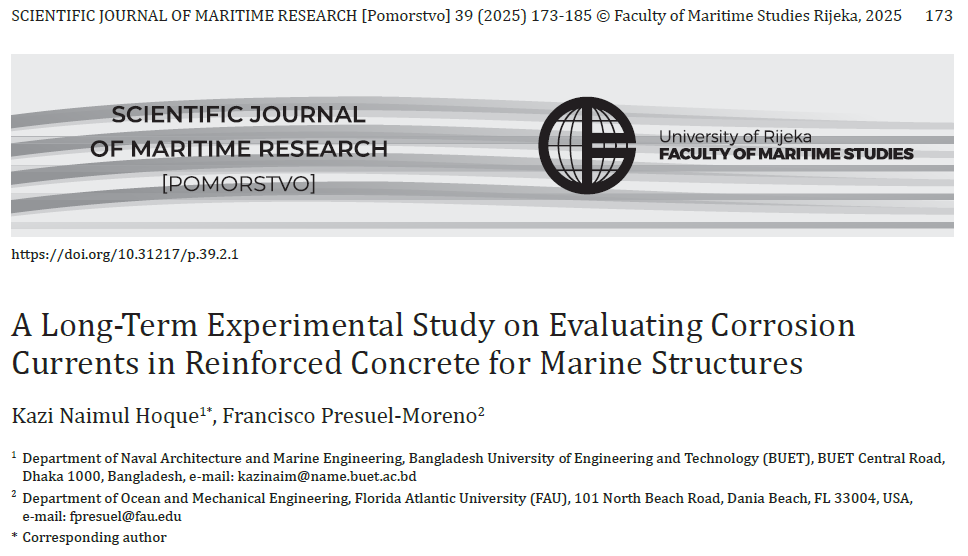A Long-Term Experimental Study on Evaluating Corrosion Currents in Reinforced Concrete for Marine Structures
Keywords:
Concrete mix, fly ash, slag, silica fume, reservoir length, electrochemical measurements, corrosion currentAbstract
This study investigates the corrosion currents in four reinforced concrete mixes—SL (cement replacement of 50% slag), FA (cement replacement of 20% fly ash), T1 (cement replacement of 50% slag and 20% fly ash), and T2 (cement replacement of 20% fly ash and 8% silica fume)—using an electromigration method to accelerate chloride transport and initiate corrosion within weeks/months. The corrosion propagation was monitored over 1600 days using electrochemical techniques such as
Linear Polarization Resistance (LPR), Electrochemical Impedance Spectroscopy (EIS), and Galvanostatic Pulse (GP) measurements. The study evaluated how the composition of the concrete mixes and reservoir length influenced corrosion, by testing both binary mixes (SL and FA) and ternary mixes (T1 and T2). The results show that the LPR readings, which uses prolonged polarization, generally produces higher corrosion current values than GP readings, offering a dynamic view of corrosion but greater variability. The binary mixes with slag (SL) or fly ash (FA) exhibit higher corrosion currents, while ternary mixes, especially those containing fly ash and silica fume (T2), show reduced corrosion currents, suggesting
improved resistance. The larger reservoir length contributed to higher corrosion currents, highlighting the critical influence of exposure conditions, concrete mix composition, and measurement techniques in evaluating corrosion. This underscores the importance of considering these factors collectively when assessing the durability and long-term performance of concrete in corrosive environments.

Downloads
Published
Issue
Section
Categories
License
Copyright (c) 2025 Kazi Naimul Hoque, Francisco Presuel-Moreno

This work is licensed under a Creative Commons Attribution-NonCommercial-NoDerivatives 4.0 International License.
Scientific Journal of Maritime Research understands the need for authors to disseminate and maximize the impact of their research. When submitting an article for publishing in Scientific Journal of Maritime Research, it implies that the Corresponding Author transfers, with the consent of all Coauthors, the copyright ownership in the referenced submission, including all versions in any format now known or hereafter developed, to the Scientific Journal of Maritime Research.
Copyright protects your original work and research material and prevents others from using it without your permission. Others will be required to credit you and your work properly, thus increasing its impact. Should your submission be rejected or withdrawn prior to acceptance for publication by Scientific Journal of Maritime Research, this transfer will be null and void.
Authors, users or readers of an article need clear instructions on how they can use the article. Scientific Journal of Maritime Research uses the Creative Commons Attribution-NonCommercial-NoDerivatives (CC-BY-NC-ND) 4.0 International License, which governs the use, publishing and distribution of articles by authors, publishers and the wider general public.
The authors are allowed to post a digital file of the published article, or the link to the published article (Scientific Journal of Maritime Research web page) may be made publicly available on websites or repositories, such as the Author’s personal website, preprint servers, university networks or primary employer’s institutional websites, third party institutional or subject-based repositories, and conference websites that feature presentations by the Author(s) based on the published article, under the condition that the article is posted in its unaltered Scientific Journal of Maritime Research form, exclusively for non-commercial purposes.




